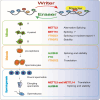Epigenetic regulations in mammalian spermatogenesis: RNA-m6A modification and beyond
- PMID: 33835194
- PMCID: PMC11073063
- DOI: 10.1007/s00018-021-03823-9
Epigenetic regulations in mammalian spermatogenesis: RNA-m6A modification and beyond
Abstract
Emerging evidence shows that m6A, one of the most abundant RNA modifications in mammals, is involved in the entire process of spermatogenesis, including mitosis, meiosis, and spermiogenesis. "Writers" catalyze m6A formation on stage-specific transcripts during male germline development, while "erasers" remove m6A modification to maintain a balance between methylation and demethylation. The different functions of RNA-m6A transcripts depend on their recognition by "readers". m6A modification mediates RNA metabolism, including mRNA splicing, translation, and degradation, as well as the maturity and biosynthesis of non-coding RNAs. Sperm RNA profiles are easily affected by environmental exposure and can even be inherited for several generations, similar to epigenetic inheritance. Here, we review and summarize the critical role of m6A in different developmental stages of male germ cells, to understand of the mechanisms and epigenetic regulation of m6A modifications. In addition, we also outline and discuss the important role of non-coding RNAs in spermatogenesis and RNA modifications in epigenetic inheritance.
Keywords: Epigenetic inheritance; RNA modification; Sperm RNA; Spermatogenesis; m6A.
Conflict of interest statement
The authors declare no conflict of interests.
Figures



Similar articles
-
[The Roles of N6-Methyladenosine Modification and Its Regulators in Male Reproduction].Sichuan Da Xue Xue Bao Yi Xue Ban. 2024 May 20;55(3):527-534. doi: 10.12182/20240560103. Sichuan Da Xue Xue Bao Yi Xue Ban. 2024. PMID: 38948273 Free PMC article. Review. Chinese.
-
The effects of diabetes on male fertility and epigenetic regulation during spermatogenesis.Asian J Androl. 2015 Nov-Dec;17(6):948-53. doi: 10.4103/1008-682X.150844. Asian J Androl. 2015. PMID: 25814158 Free PMC article. Review.
-
Epigenetic germline inheritance in mammals: looking to the past to understand the future.Genes Brain Behav. 2018 Mar;17(3):e12407. doi: 10.1111/gbb.12407. Epub 2017 Sep 6. Genes Brain Behav. 2018. PMID: 28782190 Review.
-
Epigenetic processes in the male germline.Reprod Fertil Dev. 2015 Jun;27(5):725-38. doi: 10.1071/RD14167. Reprod Fertil Dev. 2015. PMID: 25200708 Review.
-
Epigenetic regulation of mRNA N6-methyladenosine modifications in mammalian gametogenesis.Mol Hum Reprod. 2021 May 8;27(5):gaab025. doi: 10.1093/molehr/gaab025. Mol Hum Reprod. 2021. PMID: 33823008 Review.
Cited by
-
Reading the m6A-encoded epitranscriptomic information in development and diseases.Cell Biosci. 2024 Sep 28;14(1):124. doi: 10.1186/s13578-024-01293-7. Cell Biosci. 2024. PMID: 39342406 Free PMC article. Review.
-
Photoperiod alters testicular methyltransferase complex mRNA expression in Siberian hamsters.Gen Comp Endocrinol. 2023 Mar 1;333:114186. doi: 10.1016/j.ygcen.2022.114186. Epub 2022 Dec 12. Gen Comp Endocrinol. 2023. PMID: 36521516 Free PMC article.
-
Joint analysis of m6A and mRNA expression profiles in the testes of idiopathic nonobstructive azoospermia patients.Front Endocrinol (Lausanne). 2022 Dec 15;13:1063929. doi: 10.3389/fendo.2022.1063929. eCollection 2022. Front Endocrinol (Lausanne). 2022. PMID: 36589848 Free PMC article.
-
NAT10-mediated N4-acetylcytidine modification is required for meiosis entry and progression in male germ cells.Nucleic Acids Res. 2022 Oct 28;50(19):10896-10913. doi: 10.1093/nar/gkac594. Nucleic Acids Res. 2022. PMID: 35801907 Free PMC article.
-
Characteristic analysis of N6-methyladenine in different parts of yak epididymis.BMC Genomics. 2025 May 19;26(1):500. doi: 10.1186/s12864-025-11684-w. BMC Genomics. 2025. PMID: 40389816 Free PMC article.
References
-
- Abe K, Shen LS, Takano H. The cycle of the seminiferous epithelium and stages in spermatogenesis in dd-mice. [Hokkaido igaku zasshi] Hokkaido J Med Sci. 1991;66(3):286–299. - PubMed
Publication types
MeSH terms
Substances
Grants and funding
LinkOut - more resources
Full Text Sources
Other Literature Sources

